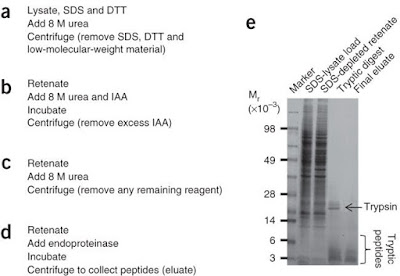This a question many lab managers facing nowadays, since mass spectrometer have already conquered almost every lab bench world wide. Since I am working with the hardware I am a biased however I am going to try to be as objective as possible.
They are several mass spec vendor out there and I guess most of you working in the field are familiar with the Thermo's, Water's or ABSciex's. All of them provide a portfolio ranging from simple triple quadrupole systems (QqQ) over the advanced Fourier Transform Ion Cyclotron Resonance (FTICR) systems to the modern hybrid systems, such as Q-TOF. For each of the selected systems I try to evaluate the following nine parameters
1) sensitivity
2) mass accuarcy
3) resolution
4) scan speed
5) calibration stability
6) scan modes
7) vacuum technique
8) maintenance
9) investment
The sensitivity depends on the chemical properties analyte and therefore on the ionization efficiency for a given technique. Once ionized one likes to transmit all ions to the detecto. Eventhough current instruments show improved ion transmission, ultimate transmission is tough to achieve.
Major losts of ions (in a range of multiple orders of magnitude) occur during the transfer from solution into the gas phase, ion transport from atmosphere into the vacuum, ion selection, ion fragmentation and ion detection. Scan modes selecting and detecting only a single ion species helping to lower the losts significantly, but do not provide the enough peak capacity to deciper a complex cell lysates.
In order to increase the ion throughput scan modes such as multiple reactant monitoring are parallel reactant monitoring or modes in which small mass windows of 25Dalton are fragmented without prior selection are implemented. Innovative scan modes in combination with new lens designs, ion optics and unique instrument configurations trying to further close the transmission gap and provide lower levels of detection and quantification.
Quadrupole and ion traps mass spec stand out because of the simplicity, but show reduced performance compared to high resolution instruments (such as TOF or FTICR). Both can scan really fast but provide only mass resolutions of less then 10000 FWHM and mass accuracies of millidaltons (first decimal digits is correct). Additionally ion traps are capable of performing an MSn experiment, which enlabeles one to fragment ions and their fragments multiple times for structural elucidation.
This means ions traps are able to store, select, fragment and detect ions all in the same location. However, limited ion capacities can lead to space charge and therefore limit the mass accuracy of this system.
Quadrupoles lets you mass analyze and filter ions. Since the performance of a quadrupole as mass analysis is rather weak, its high transmission and filtering function gets utilize in many hybrid instruments, where properties of two or more analyses are used.
In terms of resolution stand-only FTICR systems provide the highest resolution. Resolutions of more than 10.000.000 FWHM are possible. Isotopic distribution can be undoubtfully identified (see image) But it comes with the downside of a long duty cycle of more then 20 secs for a single high resolution MS scan. This is of importance especially when it come to hyphenated methods such as LCMS. Depending on the time dimension and resolution of the upstream methodology one has to find the optimal balance between speed and resolution, otherwise one will miss compounds eluting from the upstream device will the MS detector is still acquiring.
One concept to overcome this is the use of the trapping device. FTICR it is a trapping device with a decent capacitance. The issue arises when the detector is busy doing the mass analysis, ions can not be injected into the detector. The best would be to store them in front of the detector.
This is for example one of the adavantages of the orbitrap systems which have an high capacity trap in front of the actual analyser. So trapping and mass analysis can be performed in parallel on an milli second time scale.
Oribtrap system can provide resolutions of 200.000 FWHM and more. Similar to FTICR orbitrap, which also utilizes Fourier Transform Theorem, resolution is directly proportional to the scan time.
There is a technology out there in which resolution does not depend on the scan time, it is actually undependent from scan time. The Time-of-fligh technology. TOF displays a scan time of a few 100 microscans for a single MS scan and is therefore among the fastest when it comes to mass analysis however the resolution is limited to the length of the flight path. The following graph displays resolution vs. scan times for a TOF instrument (red line) and for FT-instrument (blue line).
The long flight tube displays a temperature gradient which leads to shifts in mass position. Therefore TOF systems require an lock mass for recalibration of mass position. FTICR and orbitrap using lock masses as well, but since there are much more compact compared to TOF they are less prone to shift of mass position.
In terms of maintanence and vacuum technique FT system require a lot more attention then TOF system. First of all, due to there much higher vacuum. FT-ICR or FT-orbitrap system operating in the 1x10^-10 mbar range where as TOF system operate in the range of 1x10^-7 mbar. This is mainly due to the different vacuum space requirements that should be evacuated. In generall all these systems have 3 or more pumps to establish the different vacuum regions. In order to reduce maintenance effort and lower system downtime one should consider of using oil free rough pumps and robust high vacuum turbopumps.
Well, but the huge magnet and the corresponding cryogenic cooling system make the FT-ICR to the system with the highest running expenses and also investment costs compared to TOF and orbitrap.








































